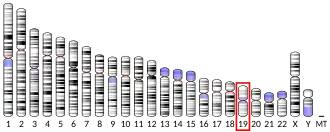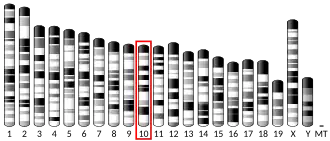Excitatory amino-acid transporter 4 (EAAT4) is a protein that in humans is encoded by the SLC1A6 gene.[5][6]
EAAT4 is expressed predominantly in the cerebellum, has high affinity for the excitatory amino acids L-aspartate and L-glutamate. When stimulated by these amino acids, EAAT4 conducts chloride ions.[6]
References
Further reading
- Deng X, Shibata H, Takeuchi N, et al. (2007). "Association study of polymorphisms in the glutamate transporter genes SLC1A1, SLC1A3, and SLC1A6 with schizophrenia". Am. J. Med. Genet. B Neuropsychiatr. Genet. 144B (3): 271–8. doi:10.1002/ajmg.b.30351. PMID 17221839. S2CID 42347750.
- Need AC, Keefe RS, Ge D, et al. (2009). "Pharmacogenetics of antipsychotic response in the CATIE trial: a candidate gene analysis". Eur. J. Hum. Genet. 17 (7): 946–57. doi:10.1038/ejhg.2008.264. PMC 2986499. PMID 19156168.
- Poulsen MV, Vandenberg RJ (2001). "Niflumic acid modulates uncoupled substrate-gated conductances in the human glutamate transporter EAAT4". J. Physiol. 534 (Pt 1): 159–67. doi:10.1111/j.1469-7793.2001.00159.x. PMC 2278676. PMID 11432999.
- Stelzl U, Worm U, Lalowski M, et al. (2005). "A human protein-protein interaction network: a resource for annotating the proteome". Cell. 122 (6): 957–68. doi:10.1016/j.cell.2005.08.029. hdl:11858/00-001M-0000-0010-8592-0. PMID 16169070. S2CID 8235923.
- Jackson M, Song W, Liu MY, et al. (2001). "Modulation of the neuronal glutamate transporter EAAT4 by two interacting proteins". Nature. 410 (6824): 89–93. Bibcode:2001Natur.410...89J. doi:10.1038/35065091. PMID 11242047. S2CID 4381210.
- Rajamanickam J, Palmada M, Lang F, Boehmer C (2007). "EAAT4 phosphorylation at the SGK1 consensus site is required for transport modulation by the kinase". J. Neurochem. 102 (3): 858–66. doi:10.1111/j.1471-4159.2007.04585.x. PMID 17442044. S2CID 30779935.
- Gratacòs M, Costas J, de Cid R, et al. (2009). "Identification of new putative susceptibility genes for several psychiatric disorders by association analysis of regulatory and non-synonymous SNPs of 306 genes involved in neurotransmission and neurodevelopment". Am. J. Med. Genet. B Neuropsychiatr. Genet. 150B (6): 808–16. doi:10.1002/ajmg.b.30902. PMID 19086053. S2CID 44524739.
- Strausberg RL, Feingold EA, Grouse LH, et al. (2002). "Generation and initial analysis of more than 15,000 full-length human and mouse cDNA sequences". Proc. Natl. Acad. Sci. U.S.A. 99 (26): 16899–903. Bibcode:2002PNAS...9916899M. doi:10.1073/pnas.242603899. PMC 139241. PMID 12477932.
- Grimwood J, Gordon LA, Olsen A, et al. (2004). "The DNA sequence and biology of human chromosome 19" (PDF). Nature. 428 (6982): 529–35. Bibcode:2004Natur.428..529G. doi:10.1038/nature02399. PMID 15057824. S2CID 4420825.
|
|---|
By group |
|---|
SLC1–10 |
|---|
| (1): | |
|---|
| (2): | |
|---|
| (3): | |
|---|
| (4): | |
|---|
| (5): | |
|---|
| (6): | |
|---|
| (7): | |
|---|
| (8): | |
|---|
| (9): | |
|---|
| (10): | |
|---|
|
| SLC11–20 |
|---|
| (11): |
- proton coupled metal ion transporter
|
|---|
| (12): | |
|---|
| (13): |
- human Na+-sulfate/carboxylate cotransporter
|
|---|
| (14): | |
|---|
| (15): |
- proton oligopeptide cotransporter
|
|---|
| (16): |
- monocarboxylate transporter
|
|---|
| (17): | |
|---|
| (18): | |
|---|
| (19): | |
|---|
| (20): | |
|---|
|
| SLC21–30 |
|---|
| (21): | |
|---|
| (22): | |
|---|
| (23): |
- Na+-dependent ascorbic acid transporter
|
|---|
| (24): | |
|---|
| (25): | |
|---|
| (26): |
- multifunctional anion exchanger
|
|---|
| (27): | |
|---|
| (28): |
- Na+-coupled nucleoside transport (SLC28A1
|
|---|
| (29): |
- facilitative nucleoside transporter
|
|---|
| (30): | |
|---|
|
| SLC31–40 |
|---|
| (31): | |
|---|
| (32): | |
|---|
| (33): | |
|---|
| (34): |
- type II Na+-phosphate cotransporter
|
|---|
| (35): |
- nucleoside-sugar transporter
-
-
-
-
- SLC35E1
- SLC35E2
- SLC35E3
- SLC35E4
|
|---|
| (36): | |
|---|
| (37): |
- sugar-phosphate/phosphate exchanger
|
|---|
| (38): |
- System A & N, sodium-coupled neutral amino-acid transporter
|
|---|
| (39): | |
|---|
| (40): |
- basolateral iron transporter
|
|---|
|
| SLC41–48 |
|---|
| (41): | |
|---|
| (42): | |
|---|
| (43): |
- Na+-independent, system-L like amino-acid transporter
|
|---|
| (44): | |
|---|
| (45): |
- Putative sugar transporter
|
|---|
| (46): | |
|---|
| (47): | |
|---|
| (48): | |
|---|
|
| |
|
|
|
see also solute carrier disorders |
|
|---|
| Transporter | | EAATsTooltip Excitatory amino acid transporters | |
|---|
| vGluTsTooltip Vesicular glutamate transporters | |
|---|
|
|---|
| Enzyme | | GAHTooltip Glutamine aminohydrolase (glutaminase) | |
|---|
| ASTTooltip Aspartate aminotransferase |
- 2-Amino-3-butenoic acid
- AAOA
- AMB
- β-DL-Methylene-aspartate
- Hydrazinosuccinate
|
|---|
| ALTTooltip Alanine aminotransferase | |
|---|
| GDHTooltip Glutamate dehydrogenase | |
|---|
| GSTooltip Glutamine synthetase | |
|---|
| GADTooltip Glutamate decarboxylase | |
|---|
|
|---|
See also: Receptor/signaling modulators • Ionotropic glutamate receptor modulators • Metabotropic glutamate receptor modulators • GABA metabolism and transport modulators |



